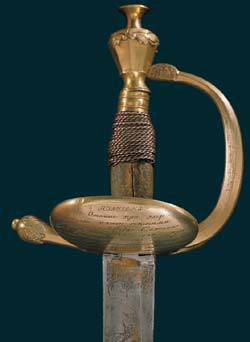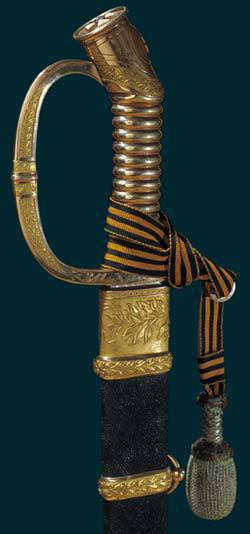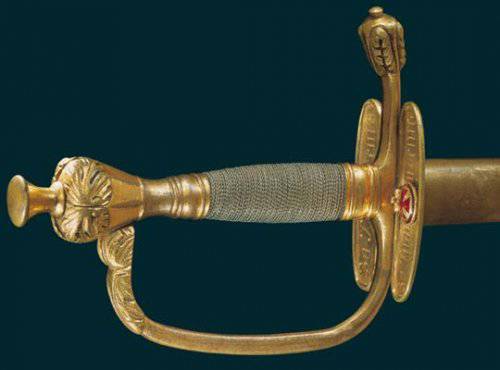Grandmaster Cunning
В stories Russian premium blades 1788 year is not in vain considered significant. If before this time Golden Weapons were only favored by representatives of the generals, then the end of the XVIII century was marked by the appearance of another type of award weapon intended for delivery to officers especially distinguished in battles, also golden, but without precious decorations.
This was explained primarily by the fact that it was at that time that Russia had to fight on two fronts long enough. In September, the 1787 of the war began with Turkey, and in the summer of 1788, realizing that all the main military forces of the Russian army are concentrated in the south, Sweden decided to take advantage of the situation in order to regain itself previously lost in wars with Russia. And although there was no official declaration of war, the hostilities launched by the Swedes near the northern borders of the Russian Empire were a very serious threat.
Successful actions of Russian troops, during which mass heroism and unparalleled courage were shown, demanded well-deserved awards, not only for senior military officials, but also for officers. So there appeared the Golden officers' swords with the inscription “For courage”. And although the type of this inscription did not change over the next 130 years, it did not develop immediately. In any case, after the Russian troops mastered the Ochakov fortress, the first Golden officer swords with honorary inscriptions were presented, eight of which were inscribed “For the courage shown in the 7 battle of June 1788 of the year on the Ochakovskiy estuary”, and on the other twelve - the same inscription but without a date. Pretty soon, such lengthy inscriptions were replaced by a laconic "For courage." At first, these words were put on the blade, a little later - on the hilt, and after 1790, on the guard of the weapon. Moreover, the Golden officer’s weapons were issued to both land and sea officers who were particularly distinguished.
At the last stage of the Russo-Turkish war, after the famous assault of Ishmael, 24 officers were given Golden weapons. All these swords and sabers had the inscription "For courage" on both sides of the hilt. After the conclusion of peace with Sweden in 1791, the Russian army, with only one enemy left, Turkey, began to defeat it with renewed vigor. In June of that year, 4 officers were awarded with Golden Swords for the assault on Anapa, on the same days under Machin (on the Danube) the Russian corps under the command of General-General Anshef N.V. Repnin dealt a crushing blow to the 80th army of the Turks. And although many officers were awarded for this victory, judging by the documents, to date only six of the Golden Arms cavaliers for Machin are known: five of them received the Golden Sabers "For Courage" and one major of artillery - the Golden Sword with the same inscription. The last battle in the Russian-Turkish war of 1787-1791 was the battle at Cape Kaliakriya, when on July 31, 1791 the Russian squadron under the command of Rear Admiral Ushakov completely defeated the Turkish fleet. For this “naval victory” that ended with the signing of a peace treaty with Turkey, representatives of the generals and officers were awarded Golden Weapons according to the Decree of Catherine II of September 16, 1792. They received 8 award Golden swords with the inscription "For courage." In total, for the entire XVIII century, judging by existing data, about 280 officers of the regular army and became the holders of Golden weapons with the inscription "For Courage" fleet.
 By the beginning of the 19th century, the officer’s Golden Weapon was one of the most honorable military differences, which almost every commander dreamed of getting. The first battle of this century was the famous Austerlitz. And although the Russian troops suffered a crushing defeat, the Golden Weapon "For Bravery" was still given to those officers who, in the current difficult situation, were able not only to keep cool, but also in every way to help reduce the losses of the Russian army.
By the beginning of the 19th century, the officer’s Golden Weapon was one of the most honorable military differences, which almost every commander dreamed of getting. The first battle of this century was the famous Austerlitz. And although the Russian troops suffered a crushing defeat, the Golden Weapon "For Bravery" was still given to those officers who, in the current difficult situation, were able not only to keep cool, but also in every way to help reduce the losses of the Russian army.In addition to the French campaigns 1805, 1806 — 1807, before the start of the Napoleonic invasion, Russia was again forced to wage wars with Turkey (1806 — 1812) and Sweden (1808 — 1809). According to far from complete data, over the years, around 950 people were awarded with the Golden Officer Weapon "For Bravery" during the fighting. Among them: 20-year-old Guards officer Ivan Dibich, who was wounded in the right hand during the Austerlitz battle, but never left the battlefield, continuing to fight with his left; on the Turkish front - then still unknown to anyone captain, and later Field Marshal-General of the Russian Army Ivan Paskevich; in Swedish, the future famous commander of partisan detachments Denis Davydov and Colonel Yakov Kulnev. Awarded with the Golden Officer's weapons were also made for the differences in combat operations against the Highlanders in the Caucasus.
In the next decade after the Patriotic War, the Golden Weapon awards were of a single character. But from 1826 to 1829 the year when Russia did not cease hostilities with both the mountaineers in the Caucasus, and with Persia and Turkey, their number increased significantly.
Until 1844, all award-winning Golden Weapons were issued from the Emperor's Cabinet, and from April of the same year, the Gold Weapons with diamonds were still issued from the Cabinet, and the Golden Officer’s without jewelry was issued from the Chapter of Orders. And since 1814 added 10% to all expenditure sums when sending the Golden Weapon to all spending items, they went in favor of war invalids, the Chapter was asked to continue this tradition.
The Crimean War of 1853 — 1856 gave Russia 456 the Knights of the Golden Weapon “For Bravery”. In addition, almost the entire first half of the XIX century continued continuous fighting in the Caucasus. In the period from 1831 to 1849, the Golden Officer Weapon "For Bravery" was issued 176 times, and from 1850 to 1864, more than 300. And the officers who distinguished themselves in the military operations were active in Central Asia from 1853 to 1885 a year, there were more than a hundred. In the course of the Russian-Turkish war of 1877 — 1878, the Golden Weapon “For Bravery” was awarded to around 600 officers, and for the war with Japan, 1904 — 1905 was awarded more than 800.
A special page in the history of Russian award weapons was the emergence of the so-called Anninsky weapons. This variety was associated with the Order of St. Anne, established as early as 1735 in the year of Holstein-Gottorp Duke Karl Friedrich in memory of his deceased wife Anna, daughter of the first Russian emperor Peter, and who had the same degree. After the death of Charles, the throne of the duchy of Golshtinsky passed to his son Karl Peter Ulrich, who was later destined to become Russian emperor Peter III. When, after the overthrow of Peter III, his wife Catherine II seized power, their young son, Grand Duke Pavel Petrovich, became the Duke of Holstein. Subsequently, Russia abandoned the rights to this duchy, but the Order of St. Anne remained in the country.
After the death of Catherine, on the day of his coronation - 5 on April 1797, Paul named the Order of St. Anna, among other orders of the Russian Empire. Since that time, it was divided into three degrees, the lowest of them, III, was worn on cold weapons in the form of a small circle crowned with an imperial crown, in the red enamel ring of which there was a red enamel cross, exactly the same as in the central medallion of the Order star. The badge of the Order was worn not on the inside, but on the outside of the cup, since there were no longer any reasons to hide it. The largest number of awards fell on the period of the Italian and Swiss campaigns A.V. Suvorov (1799 year), as well as at the time of successful operations of the Russian squadron under the command of Admiral FF. Ushakov in the Mediterranean campaign (1798 — 1800 years). In total, during the period of his reign, Paul granted 890 people an Annian weapon. The last of them 10 February 1801 of the year, a few days before the emperor's death, became captain PG Butkov.
In 1815, Emperor Alexander I divided the Order into four degrees, henceforth his III degree was a cross worn on a ribbon on his chest, and IV, again the last, a weapon. In 1829, the first official statute of the order of St. Anna, according to which on the Anninsky weapons received for military distinction, was placed not only the badge of the order, but also the inscription "For courage". Unlike other Russian orders, the lowest degree of the Order of St.. Anna was not withdrawn from the award-winner, even if he received a higher degree. Weapons continued to be worn as a mark of distinction obtained in battle. In the Statute of the Order, dated the same 1829 year, it was stipulated that the mark of his IV degree can be worn on all types of cold weapons, that is, not only on sabers and checkers traditional for premium weapons, but also on half-sabers, broadswords and sea dirks. The new Statute of the Order, adopted in the 1845 year, once again confirming the previous establishment, made one important change in his fate. From now on, officers practicing non-Christian religion were awarded orders decorated with the image of the State Russian eagle instead of the cross and the image of St. Anne, on Anninsky arms also fastened not a red cross, but a black double-headed eagle.
By a decree of 19 of March 1855, issued during the Crimean War of 1853 — 1856, it was prescribed for a “more visible difference” of the Order of St. Anna IV degree, given for military exploits, to wear with the Anninsky weapons "For Bravery" straps of red and golden sash with silver tassels. The clarification “for military exploits” is not accidental here - the fact is that prior to 1859, the Anninsky weapon was given to officers not only for military, but also for civil merit. And during the Crimean War 1853 — 1856, by a nominal imperial decree, it was allowed to give an IV degree of the Order of Sts. Anna doctors, who risk their lives to save those wounded on the battlefield, however, with the proviso that the inscription "For Bravery" on such premium weapons should not be.
Interestingly, the Ephesus of the Anninsky weapons, in contrast to the two other types of gold award weapons, have always been made of base metal. The very badge of the order, placed on the hilt, was made of a tombac (an alloy of copper and zinc), while any other signs of the Russian orders of all classes without exception were always made of gold. This was explained by the fact that the Anninsky weapon, being the lowest officer military award, was given out much more often than other differences. During the years of the existence of the Anninsky weapon as a prize, it was handed over to hundreds of thousands of officers. And although in the army it was not considered as honorable as the Order of St. George or the Golden Weapon "For Bravery", any officer dreamed of getting it.
 In 1913, the Order of St. George and the award gold weapon attributed to it according to the new Statute received the name of St. George, and a small enamel sign of the Order in the form of a cross was placed on it, the hilt of such weapon became not golden, as before, but gold-plated However, for your own money, replace it with gold.
In 1913, the Order of St. George and the award gold weapon attributed to it according to the new Statute received the name of St. George, and a small enamel sign of the Order in the form of a cross was placed on it, the hilt of such weapon became not golden, as before, but gold-plated However, for your own money, replace it with gold.In the outbreak of World War I, the St. George Golden Weapon became an honorable but very common type of award. This was due primarily to the unprecedented scale of military operations. The St. George Gold Premium Weapon during the years of the First World War was issued more often than ever before. Judging by the surviving documents, in 1914 it was handed to 66 officers, in 1915-m - 2 377, in 1916-m - about 2 thousands, in 1917-m - 1 257.
Despite such an impressive amount of award weapons, each candidate passed a mandatory, and very strict, verification before receiving it. At first, the regiment commander sent the submission to the division commander, enclosing eyewitness testimonies, then the documents were sent to the corps commander, army commander, military minister (or his chief of staff). The diploma for his presentation was signed by the Chancellor of Orders.
Unfortunately, most of the Golden Georgievsky weapons that have come down to us are nameless, information about its owners is rare. The St. George's Saber with a pure gold hilt and the inscription “For Bravery”, owned by Lieutenant-General of the Russian Army Iosif Romanovich Dovbor-Musnitsky, is kept in the Historical Museum.
In the Novocherkassk Museum of the History of the Don Cossacks is St. George's sword with a bronze gilt hilt, handed to Lieutenant-General Alexei Maximovich Kaledin. In addition to him, who later became a “white” general, on the fronts of the First World War, the St. George Golden Weapon was also earned by several other active members of the White movement - P.N. Krasnov, N.R. Dukhonin, A.P. Kutepov and others.
After the February Revolution, the order of awarding the Golden premium weapon remained virtually unchanged, which cannot be said about its appearance. Since February, 1917 has issued a decree “on the hilt and blades of the officer’s arms, the monograms of the emperors are no longer to be done, leaving a smooth oval in place of the monogram on the hilt”. Until that time, the hilt and blades of the officer’s arms were decorated with the monogram of the emperor, in whose reign the owner received his first officer rank. In October 17, a few days before the overthrow of the Provisional Government, it was discovered that the cross of the badge of the Order of Saint Anna of the IV degree, topped with a crown, is not appropriate at all in connection with the establishment of republican rule. But nevertheless, they did not manage to make new signs corresponding to the republican spirit ...
And in February 1918 of the year, after the Bolsheviks came to power, in connection with the seizure of weapons held by the population in the Petrograd military district, an order was issued: “As a result of the incoming petitions of the former cavaliers of the St. George weapon for keeping such as participation in the war ... I declare that the servicemen awarded in the past campaigns for military distinctions with St. George’s weapons have the right to keep such in their possession ... Commander-in-Chief of the Air Defense Forces Yeremeyev ”.
On this, in fact, the institute of Russian premium weapons, which had 300-year history, ceased to exist.
- Valery Durov | Photo by Vladimir Boyko
- http://www.vokrugsveta.ru"rel =" nofollow ">http://www.vokrugsveta.ru

Information